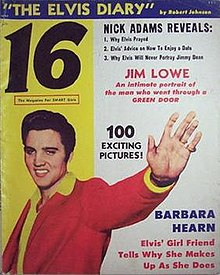16 (magazine)

Cover of the very first issue of 16 Magazine
May 1957 |
|
| Editor-in-Chief | Gloria Stavers |
|---|---|
| Categories | Teen magazine |
| Frequency | Quarterly, monthly |
| Year founded | 1956 |
| First issue | May 1957 |
| Final issue | 2001 |
| Country | USA |
| Based in | New York City |
| Language | English |
16 Magazine was a fan magazine published in New York City, sometimes credited by those in the publishing and entertainment industries as a primary influence in shaping rock journalism.
Founded in 1956, the first issue of 16 hit the newsstands in May 1957, with Elvis Presley on the cover.
However, its longtime editor-in-chief, former fashion model and subscriptions clerk Gloria Stavers, transformed 16 from a standard general-interest movie magazine into a major fan magazine focused on the preteen female as its primary reader base. Stavers was editor from 1958 until 1975. She chose to cater to that particular demographic because of the many fan letters she had read from girls aged nine through 12 writing to popular celebrities in care of the magazine, and she remembered how she felt at that age and developed a formula to increase readership in that demographic.
16's covers attracted readers by featuring sensational and hyperbole-laden headlines such as "The Day He Almost DIED!", head shots of various male entertainers, and very whimsical artwork. Although the articles were printed on newsprint, 16 featured colorful, glossy pin-up poster art.
Prior to the 1970s, most of the pin-ups of the celebrities were kept clean-cut, but 16 began to increasingly sexualize the posters they featured, in keeping with the more permissive times. 16 Magazine also often offered contests that would award the winner an opportunity to have a "meet and greet" with their favorite performer.
Most of the articles and features tended to lean on the lighter side. Rather than asking the artist serious questions about musical influences and social issues, it would offer the readers interviews asking a celebrity about his favorite color or meal, or would have him describe his "ideal girl" or dream date. If he was married, in a long term relationship, or not heterosexual in orientation, that information was kept out of the magazine, as was any news about the celebrity that even hinted at scandal.
...
Wikipedia
